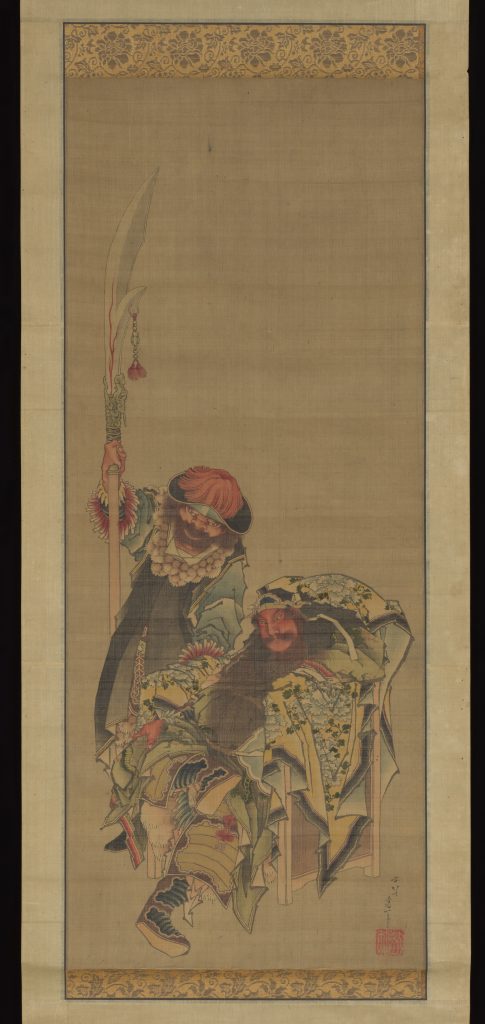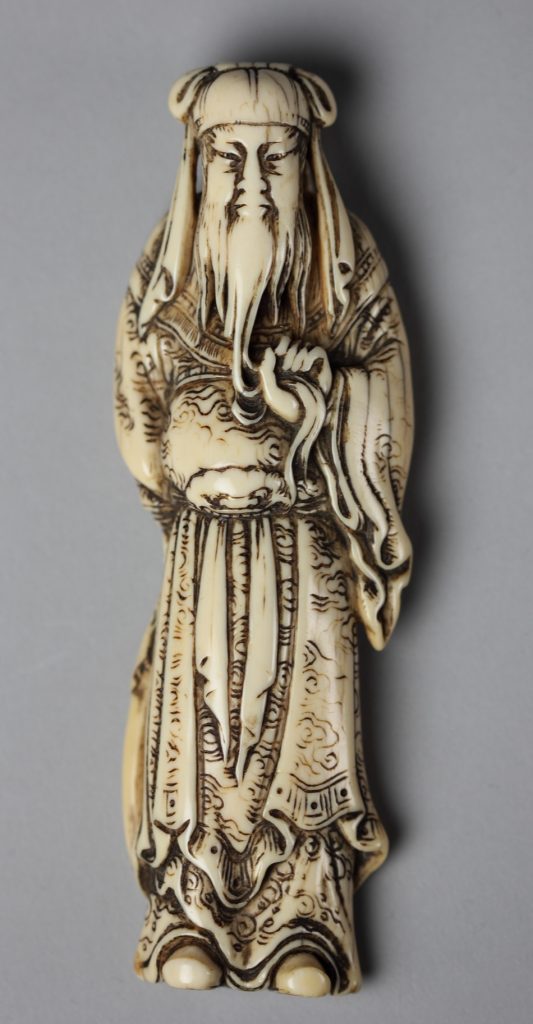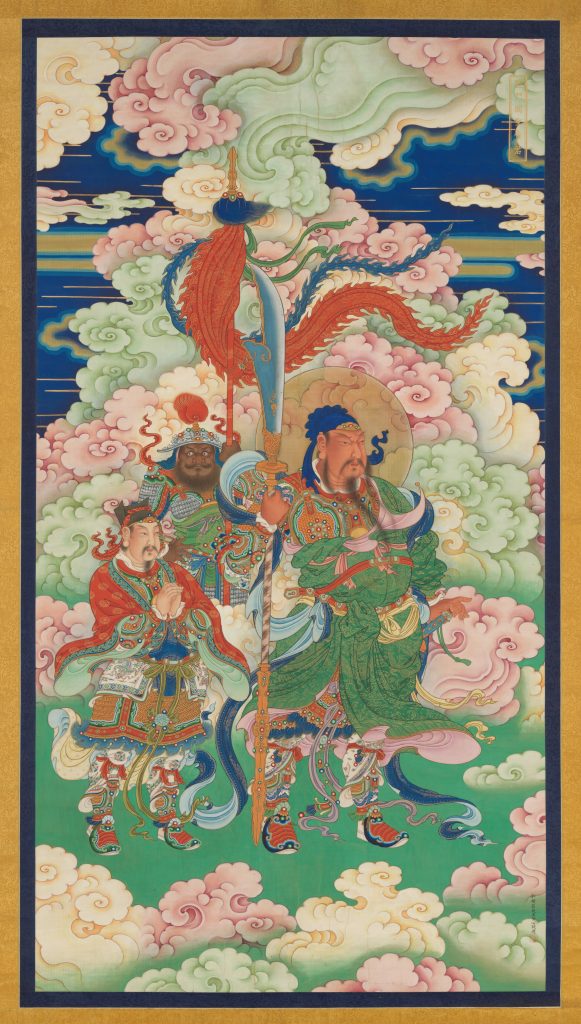14 Guan Yu – 關羽 (Guānyǔ)
M. C. Haltek
simplified Chinese: 關羽; pinyin: Guānyǔ
Guan Yu
160-220 AD
A military general, legendary warrior, hero, and historical figure who lived during the Eastern Han dynasty. Following his death he was granted the rank of emperor (di) by the Wanli Emperor during the Ming dynasty and eventually became deified. He is commonly portrayed with a red face, a long beard, and wearing green robes over battle armor. Additionally, he is commonly associated with wielding a guan dao (Chinese halberd) called the Green Dragon Crescent Blade and riding on a legendary horse named Red Hare (赤兔馬, chì tù mǎ). The Records of the Three Kingdoms is the authoritative source of his life. Popular fictional stories and exaggerated accounts are found in The Romance of the Three Kingdoms, such as crossing five passes while slaying six generals or sparing the warlord Cao Cao.
Guan Yu has many names including Měi Rán Gōng (美髯公; “Lord Magnificent Beard”), Guān Èr Gē; 關二哥; “Guan the Second Brother”), and Guān Dì (關帝; “Emperor Guan”). He is known for his bravery, loyalty, physical courage, and military prowess. These traits eventually led to his deification as a god of war and a symbol of bravery, loyalty, and righteousness. His image appears in many Taoist shrines and is a revered figure of Buddhism, Confucianism, and Chinese folk religion. Guan Yu serves as the patron god of policemen, war, fortune, law, and gangsters. Statues of Guan Yu are very common among police stations in Hong Kong, and he is still worshipped by many people today. There are thousands of worship temples dedicated to Guan Gong/Guan Di across China, with the largest one being located in Haizhou, his birthplace. Temples dedicated to Guan Yu can also be found in many Asian countries including Hong Kong, Macau, Taiwan, Vietnam, South Korea and Japan. Additionally, artwork featuring him can be observed in many museums including The Metropolitan Museum of Art and the British Museum.
In modern times, he is seen in many operas, movies and films, manhua, and video games. Guan Yu often appears in Peking operas, also known as Beijing opera, about battles during the Three Kingdoms period. Examples of these include Huarong Trail and the battle of Red Cliffs. He can be seen in films such as The Lost Bladesman (2011), Dynasty Warriors (2021), and Romance of the Three Kingdoms (1994-95). The legend of Guan Yu can be observed in many countries including Japan. Examples of manhua with Guan Yu are Sangokushi (1991-1992), SD Gundam World Sangoku Soketsuden (2019-present), and Zhen Hun Jie/Rakshasa Street (2017). Examples of video games include the Dynasty Warriors series, Smite (2014), Total War – Three Kingdoms (2019), and Wo Long: Fallen Dynasty (2023). Guan Yu also appeared on 2-ounce silver coins created by the Polish Mint featuring ancient warriors in 2019 and in 2020. Guan Yu is popular among many generations and his names, feats, and characteristics are respected and worshipped worldwide.
Ex: “Guan Yu, the second brother, is my favorite hero of the Three Kingdoms.” or “Let’s pray to Guan Gong on this auspicious day, to invoke his blessings and protections.”



Citations
“Collections Online: British Museum.” Collections Online | British Museum, .
Jarus, Owen. “Guan Yu Biography: Revered Chinese Warrior.” LiveScience, Purch, 26 Feb. 2014, https://www.livescience.com/43681-guan-yu.html.
Press, Associated. “Hong Kong Protests: Guan Yu Is the People’s Deity.” The Wall Street Journal, Dow Jones & Company, 31 Oct. 2014, https://www.wsj.com/articles/guan-yu-the-peoples-deity-1414704590.
Quan, Chris. “Guan Yu.” Guan Yu: Stories, Facts, Death, Tomb, Chinese God & Worship, 6 Dec. 2021, https://www.chinahighlights.com/travelguide/china-history/guan-yu.htm.
Tone, Sixth. “How Guan Yu Became China’s God of War, Wealth, and Everything Else.” #SixthTone, 14 Aug. 2020, https://www.sixthtone.com/news/1006043/how-guan-yu-became-chinas-god-of-war%2C-wealth%2C-and-everything-else.
“Unidentified Artist: Guan Yu: China: Qing Dynasty (1644–1911).” The Metropolitan Museum of Art, https://www.metmuseum.org/art/collection/search/62002
“Chinese General Guan Yu (Kan’u).” The Metropolitan Museum of Art, https://www.metmuseum.org/art/collection/search/60395
“Guan Yu, Chinese God of War: Katsushika Hokusai.” The Metropolitan Museum of Art, https://www.metmuseum.org/art/collection/search/45813
Media Attributions
- MET Guan Yu Scroll © Katsushika Hokusai is licensed under a Public Domain license
- MET Guan Yu Figure is licensed under a Public Domain license
- MET Guan Yu Painting is licensed under a Public Domain license

